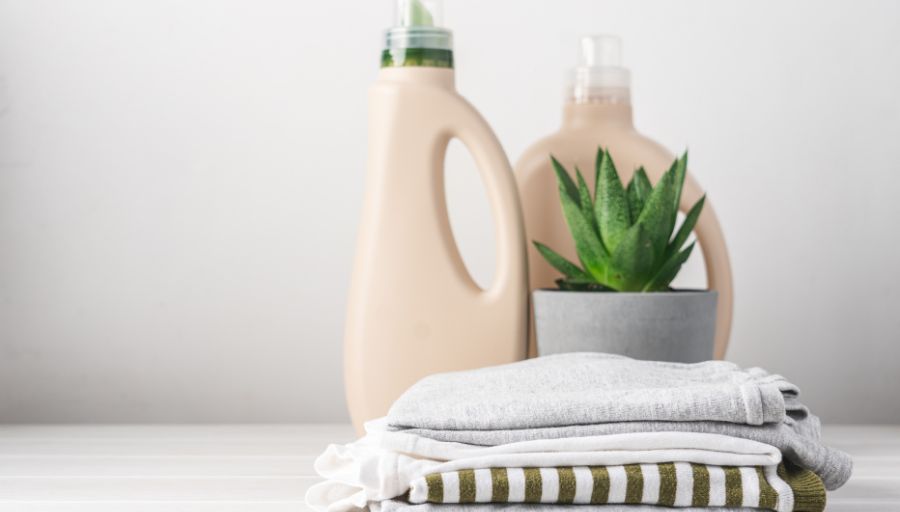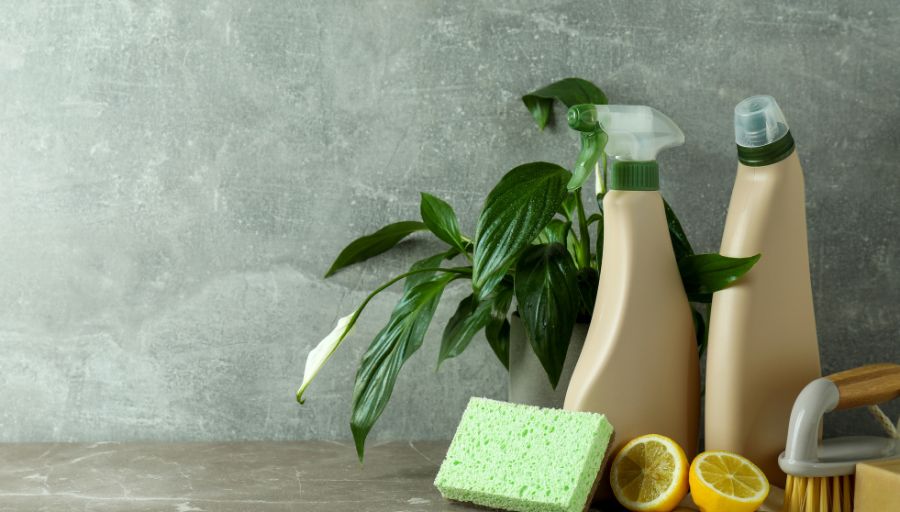Cleaning Up the Dangers: How Regular Detergents Threaten Human and Pet Health
Some things are best done the ways our grannies used to do. Simple as that. Somewhere down the line, we got lazy, and giant corporations were allowed into our homes. They promised we’d save time and hassle with their detergents, and we fell for it. They told us their products would clean better and, hence, make our homes a healthier environment for ourselves, our kids and out pets. And we fell for it.
In our quest for efficiency and cleanliness, we readily overlooked the potential dangers that lurk within our household detergents. These seemingly innocent products, designed to make our clothes brighter and our surfaces cleaner, often contain a cocktail of toxic chemicals that pose risks to both human health and that of our beloved pets.
From synthetic fragrances and harsh surfactants to preservatives and optical brighteners, conventional detergents can introduce a range of harmful substances into our homes. These chemicals can have detrimental effects on our respiratory system, skin, and overall well-being. And, they persist in the environment, polluting our land, water, and air, further jeopardizing our fragile ecosystems.
For a faster, easier solution to our problems, we are now paying a price.
But, there is a growing awareness and availability of eco-friendly alternatives that offer a safer and healthier approach to cleanliness. My 13 year-old girl Mia has cancer. Since finding out, I have been frantically searching for ways to clean my home for her, for my other pets and for us humans. So, in this post, I will show you the research I compiled regarding the dangers associated with regular household detergents, examining their impact on human and pet health as well as the environment. Then, I will end by suggesting practical and eco-conscious solutions to safeguard the well-being of our pets for fellow pet parents to empower you to make informed choices that prioritize the health and happiness of your loved ones.
Toxic chemicals – a summary
Household detergents often contain a variety of chemicals that can pose risks to both human and pet health, as well as contribute to environmental pollution. These chemicals can have adverse effects when inhaled, absorbed through the skin, or ingested.
Many conventional detergents contain synthetic fragrances, surfactants, optical brighteners, and preservatives that may be harmful. Synthetic fragrances can contain phthalates, which have been linked to hormone disruption and allergic reactions. Surfactants like sodium lauryl sulfate (SLS) and sodium laureth sulfate (SLES) can cause skin and eye irritation. Optical brighteners can accumulate in the environment and may be toxic to aquatic life. Preservatives such as parabens and formaldehyde releasers have been associated with allergies and skin sensitivities.
These chemicals can also pollute the environment. When detergents are washed down the drain, they enter wastewater treatment systems where they may not be completely removed. As a result, these chemicals can end up in rivers, lakes, and oceans, impacting aquatic ecosystems and the organisms that rely on them. Furthermore, the production and disposal of these chemicals contribute to air and water pollution during manufacturing and waste disposal processes.
Pets, particularly cats and dogs, can be more susceptible to chemical exposure due to their smaller size and increased contact with surfaces treated with detergents. They may develop skin irritations, respiratory issues, or gastrointestinal problems if exposed to toxic chemicals in detergents. Additionally, pets may accidentally ingest residues left on surfaces or on their fur during grooming.

Effects on human health in the last decade
Exposure to toxic chemicals in household detergents has been associated with various health concerns in humans. While it is important to note that individual susceptibility and the extent of exposure can vary, here are a few diseases or health conditions that have been linked to certain detergent chemicals in the last decade:
- Respiratory Issues: Some chemicals found in detergents, such as fragrances and volatile organic compounds (VOCs), can contribute to respiratory problems. These can include asthma, allergic reactions, and respiratory irritation.
- Skin Irritation and Allergies: Harsh surfactants like sodium lauryl sulfate (SLS) and sodium laureth sulfate (SLES) can strip the skin of its natural oils and disrupt the skin barrier. This can lead to dryness, irritation, and allergic reactions, such as contact dermatitis or eczema.
- Endocrine Disruption: Certain chemicals, including phthalates and parabens, found in synthetic fragrances and preservatives, have been linked to endocrine disruption. This can interfere with hormone function and potentially contribute to reproductive issues, developmental disorders, and hormonal imbalances.
- Cancer Risks: Some chemicals, such as certain fragrances and preservatives, have been classified as potential carcinogens or have raised concerns regarding their carcinogenicity. Prolonged or significant exposure to these chemicals may increase the risk of certain cancers, although the direct causal relationship can be challenging to establish.
- Environmental Sensitivities: Some individuals may develop multiple chemical sensitivities (MCS) or environmental sensitivities, experiencing adverse reactions to low levels of various chemicals present in detergents. This can lead to a range of symptoms, including headaches, dizziness, nausea, and fatigue.
Effect on pet health in the last decade
In dogs and cats, exposure to certain chemicals in household detergents can also lead to various health issues. Pet safe detergent is of the utmost importance in our pet home. While individual sensitivities can vary, here is a brief summary of some diseases or health conditions that have been associated with detergent chemicals in pets in the last decade:
- Dermatitis and Skin Irritation: Harsh detergents containing synthetic fragrances, dyes, or surfactants like SLS or SLES can cause skin irritations, allergies, or contact dermatitis in dogs and cats. Symptoms may include redness, itching, rashes, or hair loss.
- Respiratory Problems: Pets, particularly cats, can be sensitive to strong fragrances and airborne irritants present in detergents. Inhaling these chemicals can lead to respiratory issues such as coughing, sneezing, wheezing, or difficulty breathing.
- Gastrointestinal Disturbances: Accidental ingestion of detergent residues or licking surfaces treated with detergents can lead to gastrointestinal upset in pets. Symptoms may include vomiting, diarrhea, abdominal discomfort, or loss of appetite.
- Allergic Reactions: Like humans, dogs and cats can develop allergies to certain detergent chemicals. These allergies can manifest as skin reactions, respiratory issues, or gastrointestinal problems. Symptoms can vary but may include itching, hives, swelling, or breathing difficulties.
- Poisoning: In severe cases, ingestion of concentrated or toxic detergents can result in poisoning. This can cause more severe symptoms, such as drooling, seizures, lethargy, or organ damage. Immediate veterinary attention is necessary in these situations.
It’s essential to note that pets can be more sensitive to certain chemicals compared to humans, and their smaller size can make them more vulnerable to adverse effects. To protect their health, it is advisable to choose pet friendly detergents or eco-friendly detergents, thoroughly rinse surfaces, and keep pets away from freshly cleaned areas until they are dry. If any unusual symptoms or health issues arise in pets, consulting a veterinarian is recommended for proper diagnosis and treatment. A number of brands are also finally coming forward with new labels branding them as “pet safe detergent” or “pet friendly laundry detergent”. Those are the ones I am looking for. Though, they are still rare.
By the way, if you’re looking for a simple and eco-friendly solution for your pet’s hygiene, here’s a recipe for homemade pet wipes.
Fun facts on how much the average household spends on detergents
- According to Eurostat, the statistical office of the European Union, the average household expenditure on cleaning and maintenance products, which include household detergents, was around €98 per year in 2019.
- In the US, the Bureau of Labor Statistics (BLS) reported that in 2019, the average American household spent approximately $183 per year on laundry and cleaning supplies, which encompasses various cleaning products including detergents.
It’s all in the advertising, isn’t it? Ads that make us believe that we can only have clean and safe homes if we use their products work! But, what is the actual price we pay?

After doing the research for this article, I had questions. As a pet parent, I want to be sure I am informed to make the right decisions about how to provide myself and my pets a safe home for us all. So, I wrote down 10 questions I needed answered. Here we go :
1. Are there specific detergent brands or ingredients that I should avoid to protect my pets’ health?
Look for detergent brands that are labeled as pet-safe or environmentally-friendly and avoid those containing synthetic fragrances, surfactants like SLS and SLES, and harsh preservatives.
2. How can I identify if my pet is having an adverse reaction to the chemicals in detergents, and what should I do if I suspect they are experiencing health issues?
Watch for signs of adverse reactions in your pets, such as skin irritation, respiratory issues, or gastrointestinal problems. If you suspect an issue, consult your veterinarian for guidance.
3. Are there any safe and pet-friendly commercial detergent options available in the market that I can switch to?
Yes, there are pet-safe commercial detergent options available. Look for brands specifically marketed as safe for pets or consider natural detergent alternatives.
4. Can I continue using my current detergent if I ensure thorough rinsing of clothes and surfaces to minimize residue?
Thoroughly rinsing clothes and surfaces can help minimize residue and reduce potential risks, but switching to pet-safe or homemade alternatives is still advisable for long-term safety.
5. Are there any natural or homemade alternatives to commercial detergents that are effective for cleaning pet-related items, such as bedding and toys?
Yes, there are natural and homemade alternatives for cleaning pet-related items. Examples include using vinegar and baking soda or making your own detergent using gentle ingredients like castile soap.
6. How can I ensure that the water and wastewater from my home, including detergent residues, do not harm the environment and local ecosystems?
To minimize environmental impact, avoid excessive use of detergents, properly dispose of wastewater, and consider eco-friendly laundry practices such as using cold water and full loads.
7. What are the long-term effects of exposure to detergent chemicals on pets, and are certain breeds or species more susceptible to these risks?
The long-term effects of exposure to detergent chemicals on pets can vary. Consult with your veterinarian for breed-specific or species-specific risks and to discuss any concerns.
8. Are there any other household cleaning products, besides detergents, that may also pose similar risks to my pets’ health and the environment?
Yes, other cleaning products like floor cleaners and disinfectants can also pose risks. Use pet-safe or natural alternatives for a holistic approach to pet-friendly cleaning.
9. Are there any additional precautions I should take when using detergents, such as using gloves or keeping pets away from freshly cleaned surfaces until they are dry?
Take precautions like wearing gloves when using detergents and keeping pets away from freshly cleaned surfaces until they are dry to minimize exposure.
10. Can my pets safely interact with surfaces cleaned with eco-friendly or homemade detergents, or do I need to take any extra precautions?
Pets can generally interact with surfaces cleaned with eco-friendly or homemade detergents, but always monitor their behavior and consult your veterinarian if you have specific concerns.
Eco-friendly household detergents
To mitigate the risks posed by these toxic chemicals in regular household products, eco-friendly alternatives like homemade detergents using natural ingredients are the way to go from mow on. These options are typically safer for human and pet health, as they avoid harsh chemicals. Environmentally-friendly alternatives also help reduce the pollution of land, water, and air, promoting a healthier ecosystem for all living beings.
So, yeah, I researched some homemade, eco-friendly detergents for my household. A number of products were regularly mentioned. And I researched them for you too.
Castile Soap
Castile soap is a type of soap that is made from vegetable oils, traditionally olive oil, and does not contain any animal fats or synthetic ingredients. It has a long history and originated in the Castile region of Spain, hence the name.
The production of castile soap involves a saponification process, where oils or fats are combined with an alkaline solution, typically lye (sodium hydroxide), to create soap. The key characteristic of castile soap is the use of vegetable oils as the primary ingredient, which distinguishes it from other types of soaps made from animal fats or synthetic materials.
Castile soap is known for its mild and gentle nature, making it suitable for individuals with sensitive skin or allergies. It is often used in personal care products, such as body washes, shampoos, and facial cleansers. Additionally, castile soap can be utilized for various cleaning purposes, including laundry detergent, dish soap, and household cleaning solutions.
It is important to note that while castile soap is generally considered safe and eco-friendly, individual sensitivities can still occur. It is advisable to test a small amount on a patch of skin or consult with a dermatologist if you have any concerns about potential reactions.
Soap Nuts
Soap nuts are generally considered safe to use around pets like dogs, cats, and small animals such as hamsters, rabbits, or guinea pigs. However, it’s always a good idea to take some precautions and consider a few factors:
- Allergies and Sensitivities: While soap nuts are natural and hypoallergenic, some pets may have specific allergies or sensitivities to certain substances. It’s advisable to introduce any new cleaning product gradually and observe your pet for any signs of irritation or allergic reactions. If you notice any adverse reactions, discontinue use and consult a veterinarian.
- Ingestion: Some pets, especially small animals like hamsters, rabbits, or guinea pigs, may be prone to nibbling or chewing on objects. Soap nuts are not meant for consumption, and if ingested in large quantities, they could potentially cause digestive upset. Ensure that soap nuts and any liquid detergent made from them are kept securely out of reach of pets to prevent accidental ingestion.
- Residue: After washing clothes with soap nut liquid, it’s essential to rinse them thoroughly to remove any residue. While soap nuts are generally considered safe, some animals may be more sensitive to residues left on fabrics. Ensuring proper rinsing can minimize the chances of any potential skin irritations for your pets.
As with any cleaning product, it’s always a good idea to test a small, inconspicuous area or consult the care instructions of your pet’s bedding or fabrics to ensure compatibility before using soap nuts. If you have any concerns or specific questions about the safety of soap nuts for your pets, it’s best to consult with a veterinarian for personalized advice.
Washing Soda
Washing soda, also known as soda ash or sodium carbonate, is a chemical compound with the formula Na2CO3. It is a white, crystalline substance that is commonly used in various cleaning applications, including laundry detergents.
Washing soda is derived from common salt (sodium chloride) and undergoes a process called solvay process to convert it into sodium carbonate. It is highly alkaline and has a high pH, which gives it powerful cleaning properties.
In laundry detergents, washing soda helps to boost the cleaning power by acting as a water softener and pH adjuster. It helps to remove stains, grease, and dirt from fabrics effectively. Washing soda can also help to neutralize odors and brighten clothes.
It’s worth noting that washing soda is different from baking soda (sodium bicarbonate), although they are both alkaline substances. While washing soda is more caustic and powerful, baking soda is milder and has various uses in cooking, baking, and household cleaning.
When using washing soda, it’s important to handle it with care and avoid direct contact with skin or eyes. It should be stored in a dry place, away from moisture. Additionally, it is recommended to follow safety precautions and usage instructions provided on the packaging or in the recipe you are using.
So, now that we are well informed, here are a few recipes I have tried out.
Eco-friendly, homemade household detergents
When researching eco-friendly detergents I can make at home, it struck me – these are the same recipes used in my gran’s house! No frills. No secret ingredient. No chemicals. No crazy names in the ingredients. 2-4 ingredients are all it takes. And I can make a batch that will cost me a fraction of the price of those supermarket brands. So, here’s a few recipes I have been testing with.
The first recipe uses soap nuts, not easy to find everywhere. But, if you can, try this recipe.
This second video, the savings are real :
My personal suggestions
I liked using white vinegar in my laundry. First, it will act as a cleanser for your machine to clear out any residue, or scum, left behind by the soaps. Also, the bonus is how soft my clothes came out. I loved it.
And, before you read something, no, white vinegar is not too corrosive for your machine. I’ve read a number of comments from people who have been using white vinegar for their laundry and their machines are just fine! Same goes for the clothes.
Play around with essential oils. A good essential oil is a natural addition that is safe for you and for your pets. There are so many scents to choose from. And a few drops will bring out the most amazing scents. I love Jasmine. You?
PS – You, me and our pets can have a reaction to anything, even natural products. Individual sensitivities can still occur. So, test thoroughly. Rinse surfaces, and keep pets away from freshly cleaned areas until they are dry. If any unusual symptoms or health issues arise in pets, consulting a veterinarian is recommended for proper diagnosis and treatment.




